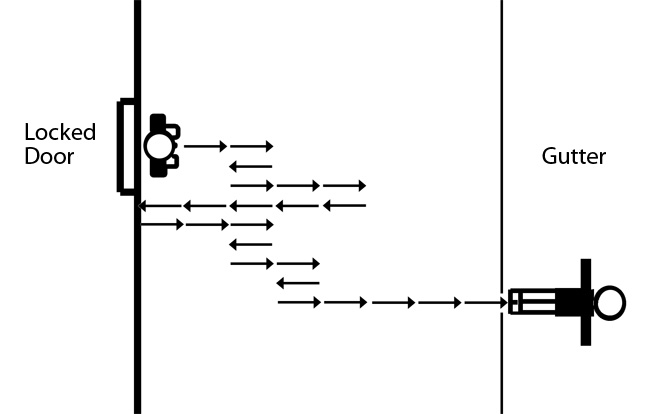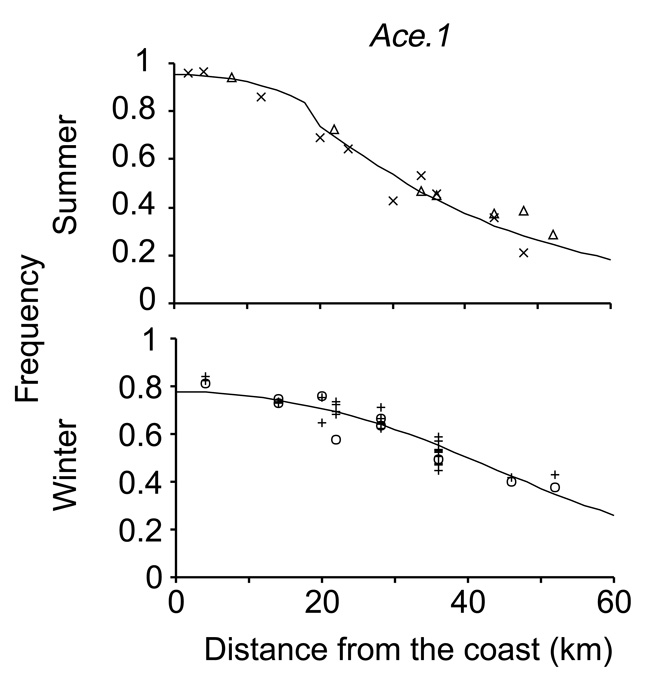what must happen in order for new species to evolve
Evolution describes changes in inherited traits of populations through successive generations. To fully empathise the science of environmental, one must first exist able to grasp evolutionary concepts.
The geneticist Theodosius Dobzhansky (1964) famously wrote "zero in biology makes sense except in the light of evolution," and the field of ecology is no exception to this broadly-embraced principle. To study ecology without an understanding of evolutionary theory is to watch a sporting event without first learning the rules — players run, points are scored, whistles shrill, merely the guiding principles underlying these events remain a mystery. With an understanding of the rules, however, fifty-fifty the smallest intricacies of the game can exist appreciated, even loved. So information technology is with ecology: Evolution provides a canon by which we may improve understand the interactions of organisms with their environments. In this department, nosotros define evolution every bit it is understood to modern biological science and as it applies to ecology.
Development is divers every bit the alter in the inherited traits of a population of organisms through successive generations. When living organisms reproduce, they pass on to their progeny a collection of traits. These traits may be tangible and obvious, such equally the patterns in a butterfly's wing or the number of scales on a crocodile, but they also include characteristics as relatively anonymous as the sequence of nucleotide bases that make up an organism's DNA. In fact, when we talk well-nigh evolutionary inheritance, the latter is what nosotros are actually referring to: the transfer of genetic sequences from one generation to the adjacent. When particular genetic sequences modify in a population (eastward.g., via mutation) and these changes are inherited across successive generations, this is the stuff of evolution.
What Evolution Is Non
The term "evolution" is unremarkably misused, often accidentally but sometimes with purpose, so it is also necessary to clarify what evolution is non.
Well-nigh importantly, evolution does not progress toward an ultimate or proximate goal (Gould 1989). Development is non "going somewhere"; information technology merely describes changes in inherited traits over time. Occasionally, and peradventure inevitably, this change results in increases in biological complication, only to interpret this every bit "progress" is to misunderstand the machinery. For instance, that single-celled organisms eventually gave ascension to multicellular organisms might appear to exemplify directed move towards so-called "higher" life-forms. Just as Gould (1996) and others bespeak out, at that place is a left-mitt wall to complexity; past definition, the simplest possible organism can just go more complex or stay the aforementioned. In this sense, evolution is a "drunkards walk" (Figure 1), wherein sure lineages inevitably attain unexplored novelty in form and role. By the same token, terms like "reverse evolution" and "devolution" are nonsensical; like traits and cistron sequences may recur at different moments in biological history, but this is still just evolution: change over time.

Figure one: The "drunkard'due south walk" as an explanatory metaphor for patterns of increasing complication in evolution
A drunken human leaving a bar at the end of the night starts with the (locked) door to his back and is equally likely to stagger to the left or to the right. Because he cannot motion back through the door, it is inevitable that he will eventually fall into the gutter despite not having made a conscious conclusion to move in that direction. Evolutionary change likewise does not progress towards a goal or final destination.
A second important signal is that evolution and natural pick are not equivalent terms. Natural selection is ane force that tin bulldoze and influence evolutionary modify, only other mechanisms can be as important. Trait changes among the members of a population are not always a result of selective processes. For instance, the appearance and accumulation of a deleterious trait (e.grand., a genetic disease) in a population should not be ascribed to direct choice for the trait in question. Similarly, alleles that accept no upshot on traits under pick may undergo mutations that do not influence the fettle of the organism carrying them. Proponents of the neutral theory of molecular evolution fence that many, if not most, of the genetic differences between species are selectively neutral. What follows is an overview of the diversity of forces, including natural choice, that tin bulldoze or otherwise influence evolutionary alter.
Microevolution and Macroevolution
I can distinguish between two general classes of evolutionary modify: microevolution (change below the level of the species) and macroevolution (modify above the level of the species).
Population ecologists, conservation biologists, and behavioral ecologists are most directly concerned with microevolutionary processes. These include shifts in the values and frequencies of item traits amongst members of populations, often due to ecological processes such equally the motility of organisms and changing ecology conditions too as interactions with members of unlike species (east.g. predator-prey interactions, host-parasite interactions, competition) or the aforementioned species (due east.grand. sexual selection, competition). These processes tin, but do not necessarily, pb to the germination of new species over fourth dimension just instead event in fluctuating frequencies of traits within populations tracking ever-irresolute selective pressures (Thompson 1998). Since some microevolutionary processes may occur over simply a few generations, they tin can oft be observed in nature or in the laboratory.
An advisable analogy of microevolution in activeness is the well-documented trend for insects to apace develop resistance to pesticides (Gassmann et al. 2009). For example, during summer in Southern France, pesticides are applied to command Culex mosquitoes from the Mediterranean declension to almost 20 km inland. Sure musquito genes confer resistance to the pesticides but are costly in the absence of pesticides (Figure 2); frequencies of the pesticide-resistance gene increase during summers in areas where spraying is mutual, only practice not increase in areas where spraying is non practiced. (Lenormand et al. 1999).

Figure 2: Frequencies of the pesticide-resistance allele Ace.1 in summer (height) and winter (lesser) populations of Culex mosquitoes in costal France
Pesticides are applied between 0 km and 20 km from the coast during summer months. Coastal frequencies of Ace.i increase during the summertime but then subtract over again in the wintertime.
Usually macroevolutionary changes cannot typically be observed straight because of the big time scales more often than not involved, though many instances of macroevolutionary change have been observed in the laboratory (Rice & Hostert 1993). Instead, studies of macroevolution tend to rely on inferences from fossil evidence, phylogenetic reconstruction, and extrapolation from microevolutionary patterns. Often the focus of macroevolutionary studies is on speciation: the process by which groups of previously-interbreeding organisms become unable (or unwilling) to successfully mate with each other and produce fertile offspring.
Ecologists may be interested in macroevolution as a means to brand inferences regarding nowadays-day ecological questions. Scientists interested in modeling the effects of nowadays-day climate modify, for case, can couple prehistoric climatological data with fossil-derived patterns of speciation and extinction to sympathise how contemporary creature and institute species are faring today and how they will fare in the future. For case, many marine invertebrates (e.thou. corals, snails, clams) construct their shells using calcium carbonate harvested from bounding main water. As anthropogenic COtwo accumulates in the atmosphere, a significant fraction of it dissolves into the ocean, releasing free hydrogen ions in the process and thus decreasing oceanic pH. Among other things, this bounding main acidification reduces the amount of carbonate available to shell-making marine invertebrates that rely on it for their calcium-carbonate shells, making it difficult for them to make and maintain their shells.
By combining oceanic pH data from hundreds of millions of years ago with fossil records of foramifera (beat out-making marine invertebrates), Zachos et al. (2005) show the furnishings that ocean acidification take had on the diversification and extinction of past marine invertebrate fauna. From these information, one can model current patterns of ocean acidification and brainstorm to predict its effects on nowadays-mean solar day and future marine animals (e.g. Orr et al. 2005).
Conclusion
Development describes changes to the inherited traits of organisms across generations. Evolutionary change is not directed towards a goal, nor is it solely dependent on natural selection to shape its path. Ecology, as with any biological discipline, is rooted in evolutionary concepts and all-time understood in its terms.
References and Recommended Reading
Dobzhansky, T. Biology, Molecular and Organic. American Zoologist iv, 443–452 (1964).
Hewitt, G. The genetic legacy of the 4th ice ages. Nature 405, 907–913 (2000).
Gassmann A .J. et al. Evolutionary analysis of herbivorous insects in natural and agricultural environments. Pest Management Science 65, 1174–81 (2009).
Gould, S. J. Wonderful Life: The Burgess Shale and the Nature of History. New York, NY: W. Due west. Norton and Company, 1989.
Gould, South. J. Full House: The Spread of Excellence from Plato to Darwin. New York, NY: Harmony Books, 1996.
Lenormand, T. et al. Tracking the evolution of insecticide resistance in the mosquito Culez pipiens. Nature 400, 861–864 (1999).
Orr, J. C. et al. Anthropogenic bounding main acidification over the twenty-first century and its touch on on calcifying organisms. Nature 437, 681–686 (2005).
Rice, Westward. R. & Hostert, Eastward. E. Laboratory experiments on speciation: what accept we learned in 40 years? Development 47, 1637–1653 (1993).
Thompson, J. N. Rapid evolution as an ecological process. Trends in Ecology and Evolution xiii, 329–332 (1998).
Zachos, J. C. et al. Rapid acidification of the ocean during the Paleocene-Eocene thermal maximum. Scientific discipline 308, 1611–1615 (2005).
Source: https://www.nature.com/scitable/knowledge/library/evolution-is-change-in-the-inherited-traits-15164254/
Post a Comment for "what must happen in order for new species to evolve"